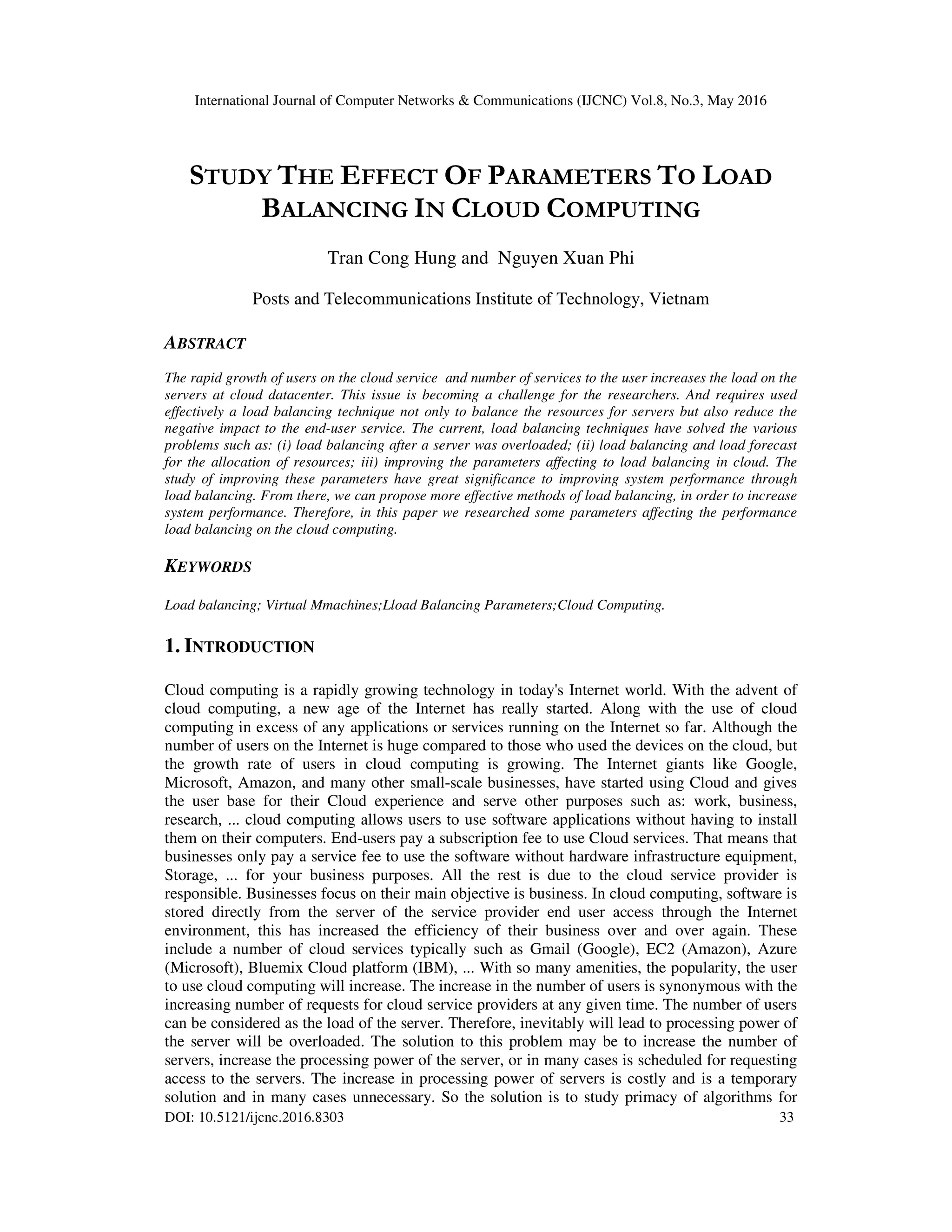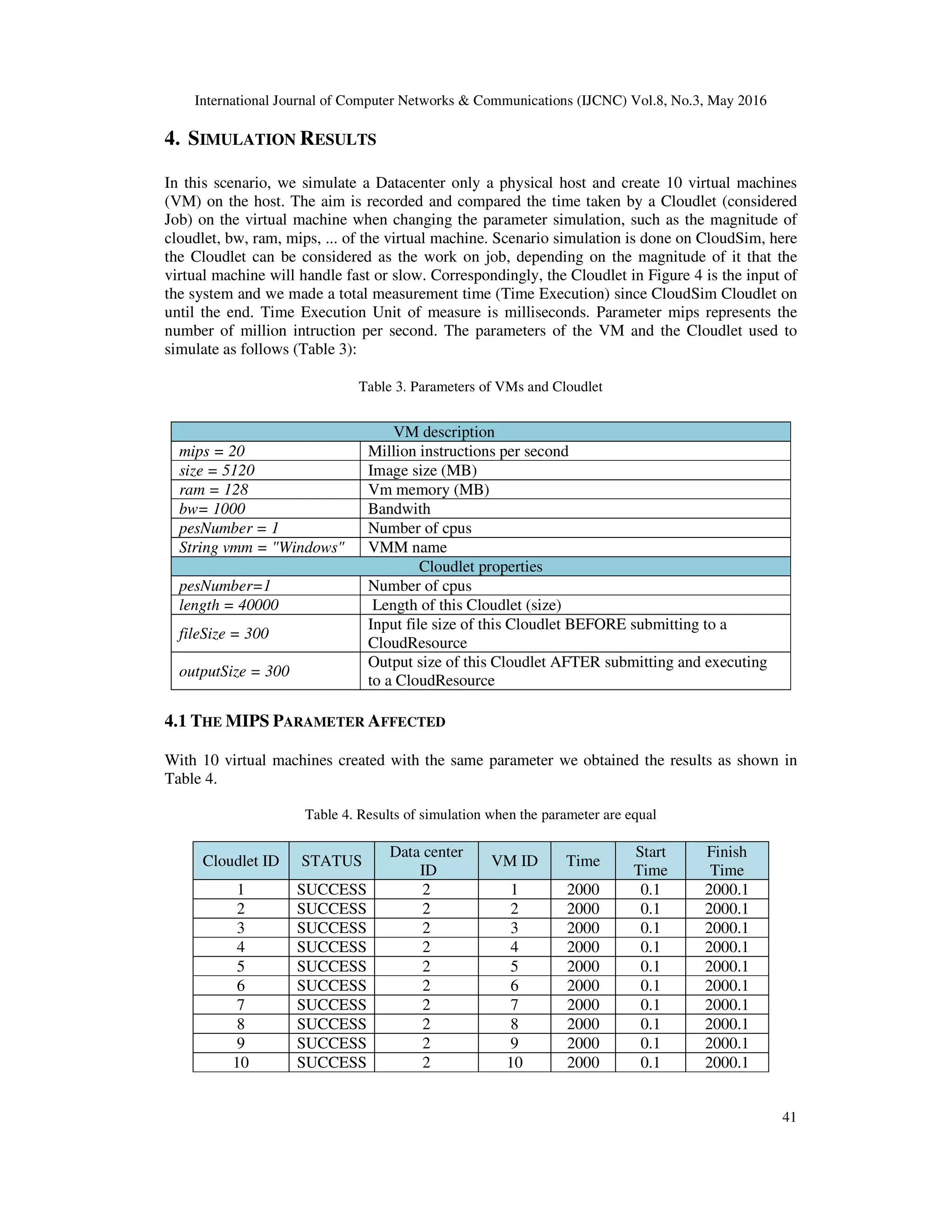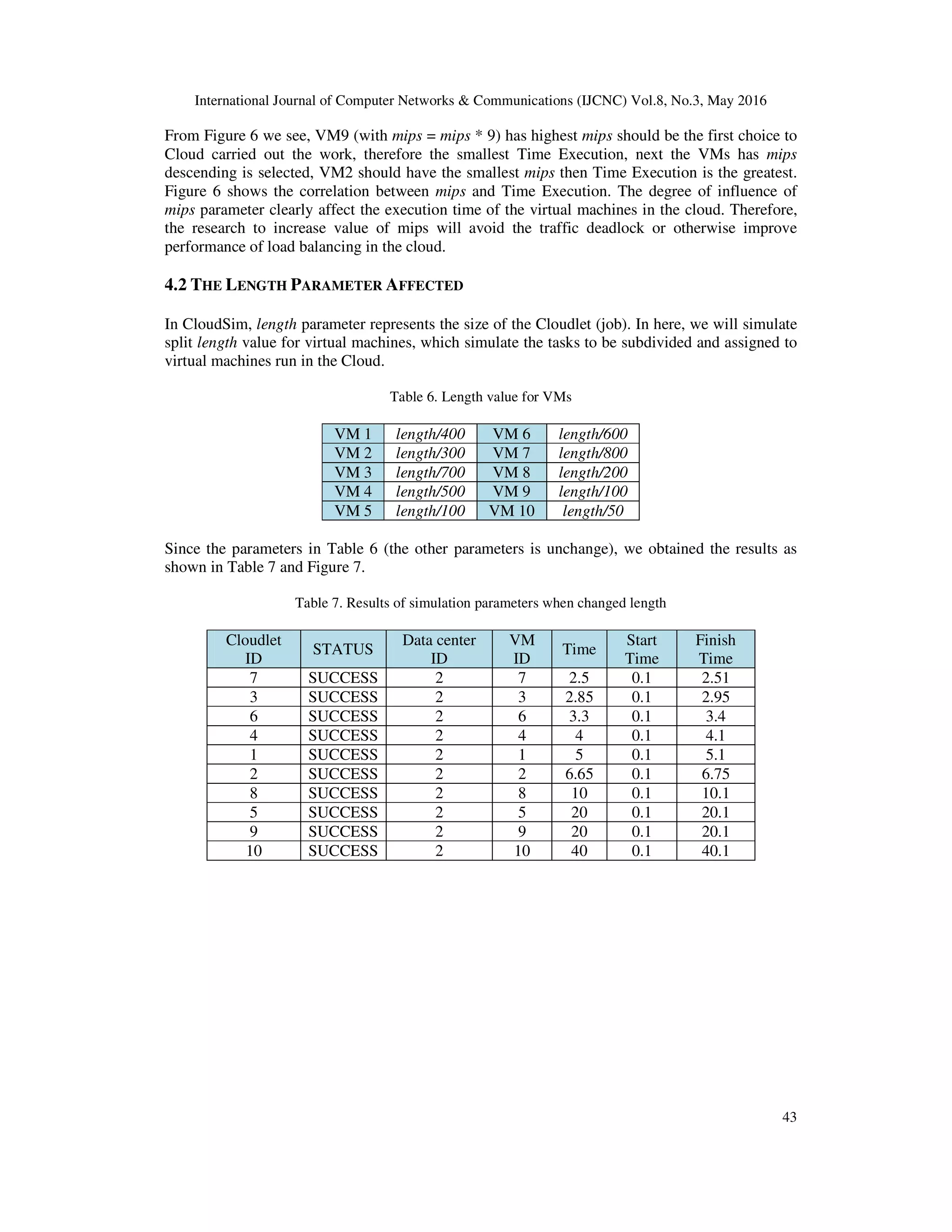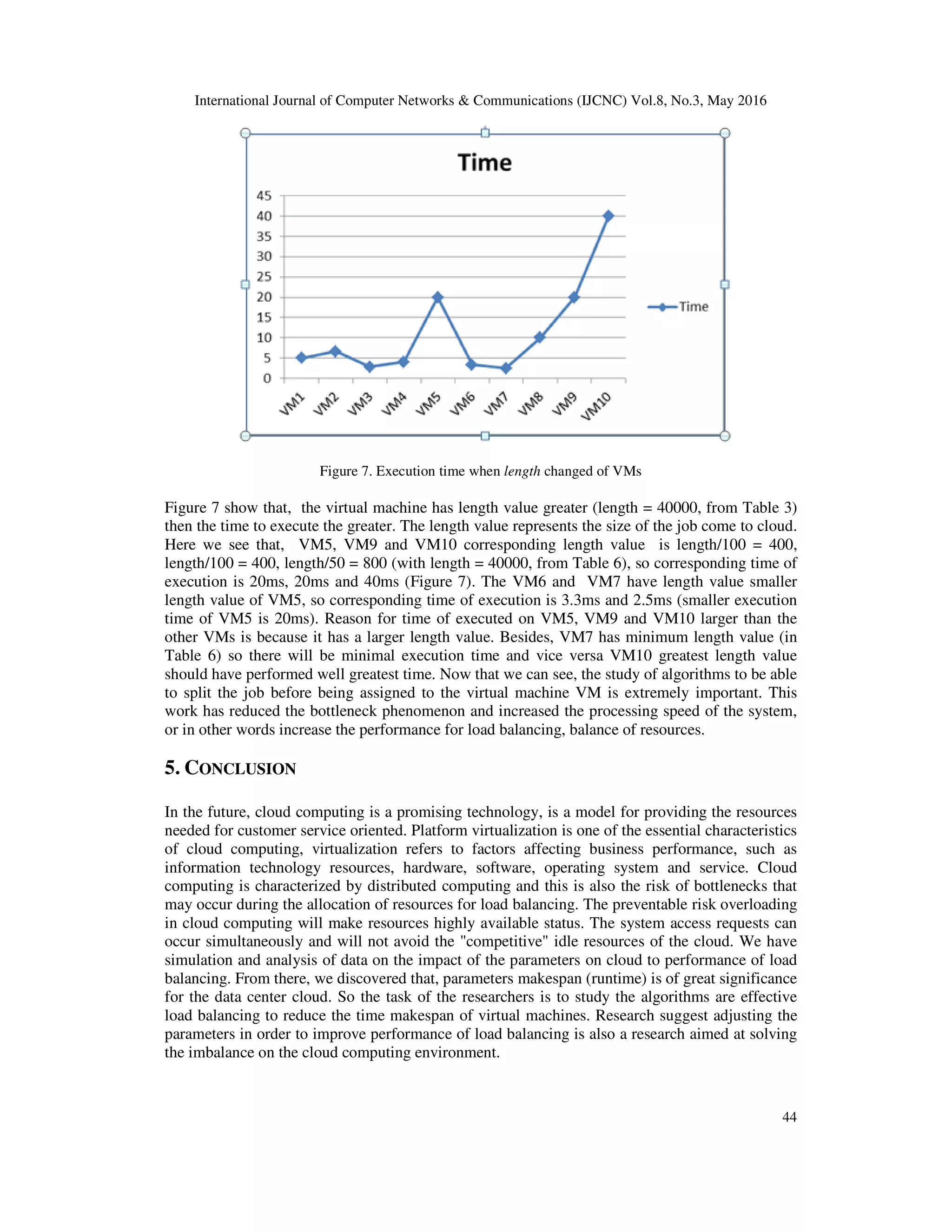The document discusses the significance of load balancing in cloud computing, due to increasing user demands that strain server resources. It examines various parameters and algorithms affecting load balancing performance, such as response time and resource utilization, and proposes improvements for efficiency. The research emphasizes the relationship between effective load balancing strategies and enhanced overall system performance in cloud environments.

![International Journal of Computer Networks & Communications (IJCNC) Vol.8, No.3, May 2016
34
resource balancing (load) on cloud computing for businesses will help service providers reduce
the considerable cost hardware infrastructure equipment.
With that approach, we studied the parameters affect the performance load balancing on the cloud
and it is the basis to propose methods for improving high performance load balancing on the
cloud. This paper is organized as follows: Part I: introduction. Part II is the related work. Section
III studies the affect of the parameters by using the tool CloudSim. Part IV simulation results and
Section V concludes.
2. RELATED WORK
In works [1], the P. Srinivasa Rao et al. refers to the elements to take a balanced approach to
effective, the information nodes of all other nodes. When a node receives a job, it has to query the
status of the other buttons to find out which node has less usage to forward the work, and when
all nodes are query phenomenon overload happens. With the nodes broadcast a statement
informed about its status will also cause huge load on the network. Next is the issue of time
wasted at each node to perform query status. Besides, the current state of the network is also a
factor affecting the performance load balancing. Because, in a complex network, with multiple
subnets, the network node configured to locate all the other node is a fairly complex task. Thus,
querying the status of nodes in the cloud will affect the performance load balancing.
The Agraj Sharma et al. [2] showed that factors response time will greatly affect the performance
load balancing on the cloud. The work [2] outlined two outstanding issues of the previous
algorithm are: i) load balancing occurs only when the server is overloaded; ii) continuous
information retrieval resources available lead to increased computational cost and bandwidth
consumption. So the authors have proposed an algorithm based on the response time of the
request to assign the required decisions for servers appropriately, the algorithm approach has
reduced the query information on available resources, reduced communication and computation
on each server. The result is simulated with ECLIPSE software using JAVA IDE 1.6 has proven
the correctness of the proposed algorithm.
According to algorithm Min – Min [3] minimizes the time to complete the work in each network
node however algorithm has yet to consider the workload of each resource. Therefore, the authors
offer algorithm Load Balance Improved Min-Min (LBIMM) to overcome this weakness. Failure
to consider the workload of each resource leading to a number of resources are overloaded, some
resources are idle; therefore, the work done in each resource is a factor affecting the performance
load balancing on the cloud. Tradition Algorithm Min - Min is simple and is the basis for the
current scheduling algorithm in cloud computing. After giving the algorithm to consider the
workload of each resource to overcome the limitations of tradition algorithm Min - Min is
algorithm LBIMM [3] for better experimental results, shown in Table 1.
Table1 . Comparison of the results of the algorithm Min - Min and LBIMM [3]
Scheduling Algorithm Min-Min LBIMM
Number of Tasks 10 10
Number of Resources 5 5
Makespan (Sec) 19.625 12.5
Average Resource Utilization
Ratio
45.29% 82.29%](https://image.slidesharecdn.com/3-160608053101/75/STUDY-THE-EFFECT-OF-PARAMETERS-TO-LOAD-BALANCING-IN-CLOUD-COMPUTING-2-2048.jpg)
![International Journal of Computer Networks & Communications (IJCNC) Vol.8, No.3, May 2016
35
In this experiment, the same value the Number of Task and Number of Resources but LBIMM
given Makespan (execution time in each resource) than less value and Average Resource
Utilization Ratio (percentage of resource use average) higher than the algorithm Min - Min.
Again shows, the study workload in the cloud resources that have great influence on the balance
of resources in the cloud. The parameters mentioned here are: Average Resource Utilization Ratio
and Makespan.
The study aims to maximize throughput, reduce latency in cloud computing is also the author
Dhinesh Babu L.D et al. [4] concerned. Because the problem of balancing resources on cloud
computing is an optimization problem NP-hard class, load balancing for independent work is a
very important priority in the scheduling algorithm on cloud. With the proposed algorithm HBB-
LB with the basic parameters are: through put, the waiting time in the queue, authors proved the
effect of these parameters on performance job scheduling avoid overloading on the cloud
environment.
In the works [5] Author Gaochao Xu and his team believe in environmental load balancing cloud
computing has a significant impact on the performance of the system. Good load balancing makes
cloud computing more effectively and improve the satisfaction of users. This work [5] introduced
a load balancing model for the Public Cloud based on the concept of Cloud Partitioning with a
conversion mechanism to choose different strategies for different situations. The division cloud
into partitions will contribute to building load-balancing strategy is effective.
Figure 1. Relationship of the Cloud Partition [5]
Figure 1 shows the relationship of cloud partitions after having broken into separate partitions [5].
In each partition has its own set of load balancing and the balance is subject to the control of the
Main Controller, select the partition decision cloud to serve, the information on the partition
(state, load level, bandwidth, ...) management focus in the Main Controller. Now that we can see,
in order to improve the efficiency of load balancing on the cloud, the division into separate
partitions cloud will improve overall system performance servers.
Hiren H. Bhatt et al. [6] propose an algorithm enhanced load balancing using flexible load sharing
algorithm (FLS). The author says, in the distributed environment, load balancing of the nodes and
task scheduling is the main concern for the designers. In the Fig 2 show the nodes of domain in
cloud scenario.](https://image.slidesharecdn.com/3-160608053101/75/STUDY-THE-EFFECT-OF-PARAMETERS-TO-LOAD-BALANCING-IN-CLOUD-COMPUTING-3-2048.jpg)
![International Journal of Computer Networks & Communications (IJCNC) Vol.8, No.3, May 2016
36
Fig. 2. Nodes of domain in cloud.
Domain of node A includes the node F and H, and B includes H, I, and D with FLS if H is the
domain of A then the domain of node H will include node A. Then node will exchange the
information from one node to another node. The third partition function will make the partition in
to each domain so that using the remote location the information will be transferred to another
domain. This research shows the basic technique for grouping the virtual machines. Divide the
virtual machines to different groups and flexible load sharing will easily workload distributed for
the virtual machines so that will reduce the overload VMs. The parameters in this study are:
virtual grouping machines, load sharing.
Ritu Kapur [7] propose an algorithm LBRS (Load Balanced Resource Scheduling Algorithm).
The idea of the algorithm is to consider the importance of resource scheduling policys and load
balancing for resources in cloud. The main goal is to maximize the CPU Utilization, maximize
the Throughput, minimize the Response Time, minimize the Waiting time, minimize the
Turnaround Time, minimize the Resource Cost and obey the Fairness princip. In here, the
parameters mentioned are QoS: throughput, response time, waiting time,…
We found that the study of the parameters affecting to load balancing in cloud very practical
sense, not only can increase performance processing by load balancing method the system but
also the scientific basis to study make effective algorithms for improving performance of load
balancing on the cloud computing. Some key parameters: throughput, response time, latency,
execution time, ... Our main goal are methods to maximize throughput, reduce response time,
minimum chemical timeout, reducing implementation time, ... to improve performance for data
center cloud.](https://image.slidesharecdn.com/3-160608053101/75/STUDY-THE-EFFECT-OF-PARAMETERS-TO-LOAD-BALANCING-IN-CLOUD-COMPUTING-4-2048.jpg)
![International Journal of Computer Networks & Communications (IJCNC) Vol.8, No.3, May 2016
37
Table 1. Analysis of existing algorithms
Author’s
Name of
Method
Parameters Findings
Srinivasa Rao et al
[1]
Dynamic load
balancing with a
centralized
monitoring
capability
Node status,
Processcor,
Job Requests
Minimizes the processing overhead on the
processors and communication/network
overhead on the network
Agraj Sharma et al
[2] Load Balancing
by considering
only the response
time of the each
request
Response
Time,
Threshold,
Prediction
Time
Considers the current responses and its
variations to decide the allocation of new
incoming requests, hence eliminates the
need of collecting further data from any
other source hence wasting the
communication bandwidth
Huankai Chen et al
[3]
Load Balance
Improved Min-
Min (LBIMM)
Makespan,
Cloud Task
Scheduling,
Average
Resource
Utilization
Ratio
Decreasing completion time of tasks,
improving load balance of resources
Dhinesh Babu L.D
et al. [4]
honey bee
behavior inspired
load balancing
(HBB-LB)
Priorities of
tasks, Honey
bee behavior
Algorithm not only balances the load, but
also takes into consideration the priorities
of tasks that have been removed from
heavily loaded Virtual Machines
Gaochao Xu et al
[5]
load balance
model for the
public cloud
based on the
cloud partitioning
concept with a
switch
mechanism
to choose
different
strategies for
different
situations
Public cloud;
Cloud
partition
Division into separate partitions cloud will
improve overall system performance
servers
Hiren H. Bhatt et
al. [6]
flexible load
sharing algorithm
(FLS).
Virtual
grouping
machines,
Load sharing
Workload distributed for the virtual
machines so that will reduce the overload
VMs.
Ritu Kapur [7] LBRS (Load
Balanced
Resource
Scheduling
Algorithm).
Throughput,
Response
time,
Waiting time
To consider the importance of resource
scheduling policys and load balancing for
resources in cloud
3. CLOUDSIM: SIMULATION TOOL FOR CLOUD COMPUTING
Tools are the authors of CloudSim works [8] announced is very useful for simulating cloud
computing environment. We used CloudSim Tool for simulation of our experiment.](https://image.slidesharecdn.com/3-160608053101/75/STUDY-THE-EFFECT-OF-PARAMETERS-TO-LOAD-BALANCING-IN-CLOUD-COMPUTING-5-2048.jpg)
![International Journal of Computer Networks & Communications (IJCNC) Vol.8, No.3, May 2016
38
3.1. THE BASIC COMPONENTS OF CLOUDSIM
Figure 3. Layered CloudSim architecture [8].
Figure 4. CloudSim class design diagram [8].](https://image.slidesharecdn.com/3-160608053101/75/STUDY-THE-EFFECT-OF-PARAMETERS-TO-LOAD-BALANCING-IN-CLOUD-COMPUTING-6-2048.jpg)
![International Journal of Computer Networks & Communications (IJCNC) Vol.8, No.3, May 2016
39
The function of the main class in CloudSim [8]:
• Cloudlet: Class of application services such as content delivery, social networking,
business data, ...
• Cloudlet Scheduler: This abstract class is expanded by the implementation of different
policies to determine the processing power of a VM Cloudlets. There are two policies:
space-shared and time-shared.
• Virtual Machines (VM): The system handles the cloud computing work. It was created
by the parameter before being handled work for the Datacenter. These parameters are:
image size, virtual memory, MIPS, bandwidth, number of CPUs.
• Vm Allocation Policy: This class represents the allocation of virtual machines and
servers. The main function is to select the server in the data center ready yet for memory,
storage for virtual machines deployed on them.
• VmScheduler: this is an abstract class that is performed by space-shared Host, time-
shared requirement to allocate processing cores to VMs
• Datacenter: This model core services layer infrastructure (hardware) provided by Cloud
providers (eg Amazon, Azure, App Engine, ...), or in other words this is the layer that
contains virtual servers to host different applications.
• DatacenterBroker or Cloud Broker: This layer acts as a broker, perform the negotiation
between SaaS and Cloud Providers negotiations is controlled by QoS. Broker represent
the SaaS Provider. It discovers the appropriate Cloud Providers by querying CIS layer
(Cloud Information Service) and online negotiating commitments to allocate resources /
services for the application QoS. The research and development system must extend this
class to evaluate and test various brokerage policy. Difference between Broker and
CloudCoordinator be understood as follows: Broker representing clients (ie decision
components to increase efficiency), while CloudCoordinator behalf of the data center (ie
trying to maximize the overall performance of the data center, without considering the
specific needs of customers.
• BwProvisioner: The main role of this part is to implement the allocation of network
bandwidth for a set of virtual machines compete on the data center. The cloud system
development, and researchers can extend this class with its policy of prioritizing (QoS) to
reflect the needs of the application. BwProvisioningSimple also allows a virtual machine
can take up a lot of bandwidth on demand and use; however, it will be limited by the total
bandwidth of the server.
• CloudCoordinator: This layer is responsible to periodically check the status of resources
in the data center and on which to undertake decisive load. These components include
special sensors and monitoring set up to handle the load. Monitoring data center
resources is done by service updateDatacenter () by sending queries to the sensor.
Services / Resource Discovery made by setDatacenter (), this method can be extended to
implement the protocols and different mechanisms (multicast, broadcast, peer-to-peer).
Besides, this component can also be extended to simulate cloud services such as Amazon
EC2 Load Balancer-. The developers aim to extend this class to implement backup
policies associated clouds (inter-cloud provisioning).
• DatacenterCharacteristics: This layer contains the configuration information of the
resources in the data center
• Host: class physical resources (computer / host) include the following information: the
amount of memory, the list of types of cores (for representing multi-core computers),
shared policies the strength of the VMs, anticipated policy (provisioning) and memory
bandwidth of VMs.
• NetworkTopology: This class reads the file to create a network topology Brite need
simulation. This information is used to simulate the latency in CloudSim network.](https://image.slidesharecdn.com/3-160608053101/75/STUDY-THE-EFFECT-OF-PARAMETERS-TO-LOAD-BALANCING-IN-CLOUD-COMPUTING-7-2048.jpg)
![International Journal of Computer Networks & Communications (IJCNC) Vol.8, No.3, May 2016
40
• RamProvisioner: this is the class that represents the memory allocation policy the main
(RAM) to the virtual machine. This class approval idle memory for the VM Host
• SanStorage: This class represents the network of Data Center storage (eg Amazon S3,
Azure blob storage). SanStorage simulation can be used to store and extract information
through the web interface without depending of time and space.
• Sensor: This interface is CloudCoordinator used to monitor specific parameters (energy
consumption, use of resources, ...). This interface is defined by the method of: i) set the
minimum and maximum thresholds for performance parameters; ii) periodically update
the measurements. Therefore, this class is used to model the actual service by cloud
vendors such as Amazon's CloudWatch, Microsoft Azure's FabricController. Each data
center can create one or more sensors, each sensor is responsible for monitoring the
various performance parameters.
3.2. NETWORK TRAFFIC FLOW IN SIMULATION
Modeling network topology to perform simulated cloud entities (host, storage capacity, users) has
significant implications because the latency of the network architecture directly affect the
experience customer services.
Figure 5. Network communication flow [8]
Looking at Figure 5 we can see, there is delay matrix in CloudSim. From entity i to entity j take
some time t + d with t is the time the message was sent, and d is the latency. The simulation using
matrix latency easier when performing simulations of routers, switches and this matrix can be
replaced by the weight or bandwidth between entities in data center. CloudSim taken from file
Brite network topology include the following information: hosts, data centers, Cloud Broker, ...](https://image.slidesharecdn.com/3-160608053101/75/STUDY-THE-EFFECT-OF-PARAMETERS-TO-LOAD-BALANCING-IN-CLOUD-COMPUTING-8-2048.jpg)




![International Journal of Computer Networks & Communications (IJCNC) Vol.8, No.3, May 2016
45
REFERENCES
[1] P. Srinivasa Rao, V.P.C Rao and A.Govardhan,“Dynamic Load Balancing With Central Monitoring
of Distributed Job Processing System”, International Journal of Computer Applications (0975 – 8887)
,Volume 65– No.21, March 2013.
[2] Agraj Sharma, Sateesh K. Peddoju, “Response Time Based Load Balancing in Cloud Computing”,
2014 International Conference on Control, Instrumentation, Communication and Computational
Technologies (ICCICCT).
[3] Huankai Chen, Frank Wang, Na Helian, Gbola Akanmu, “User-Priority Guided Min-Min Scheduling
Algorithm For Load Balancing in Cloud Computing”, Parallel Computing Technologies, 2013
National Conference.
[4] Dhinesh Babu ,Venkata Krishna P, “Honey bee behavior inspired load balancing of tasks in cloud
computing environments”, Elsevier- Journal of Applied Soft Computing, no-l3, 2013, pp-2292-2303
[5] Gaochao Xu, Junjie Pang and Xiaodong Fu, “A Load Balancing Model Based on Cloud Partitioning
for the Public Cloud”, Tsinghua Science and Technology , ISSN 1007-0214 04/12, pp 34-39, Volume
18, Number I, Febuary 2013.
[6] Hiren H. Bhatt and Hitesh A. Bheda, “Enhance Load Balancing using Flexible Load Sharing in Cloud
Computing”, 2015 1st International Conference on Next Generation Computing Technologies
(NGCT-2015) Dehradun, India, 4-5 September 2015.
[7] Ritu Kapur, “A Workload Balanced Approach for Resource Scheduling in Cloud Computing”, 2015
Eighth International Conference on Contemporary Computing (IC3), 20-22 Aug. 2015
[8] Rodrigo N. Calheiros, Rajiv Ranjan, Anton Beloglazov, Cesar A. F. De Rose and Rajkumar Buyya,
“CloudSim: a toolkit for modeling and simulation of cloud computing environments and evaluation of
resource provisioning algorithms” , Softw. Pract. Exper. 2011; 41:23–50, Published online 24 August
2010 in Wiley Online Library (wileyonlinelibrary.com). DOI: 10.1002/spe.995
AUTHORS
Tran Cong Hung was born in Vietnam in 1961. He received the B.E in electronic and
Telecommunication engineering with first class honors from HOCHIMINH University of
technology in Vietnam, 1987. He received the B.E in informatics and computer engineering
from HOCHIMINH University of technology in Vietnam, 1995. He received the master of
engineering degree in telecommunications engineering course from postgraduate department
Hanoi University of technology in Vietnam, 1998. He received Ph.D at Hanoi University of
technology in Vietnam, 2004. His main research areas are B – ISDN performance parameters and
measuring methods, QoS in high speed networks, MPLS. He is, currently, Associate Professor PhD. of
Faculty of Information Technology II, Posts and Telecoms Institute of Technology in HOCHIMINH,
Vietnam.
Nguyen Xuan Phi was born in Vietnam in 1980. He received Master in Posts &
Telecommunications Institute of Technology in Ho Chi Minh, Vietnam, 2012, major in
Networking and Data Transmission. Currently, he is a PhD candidate in Information
System from Post & Telecommunications Institute of Technology, Vietnam. He is
working at the Information Technology Center of AGRIBANK in Ho Chi Minh, Vietnam.](https://image.slidesharecdn.com/3-160608053101/75/STUDY-THE-EFFECT-OF-PARAMETERS-TO-LOAD-BALANCING-IN-CLOUD-COMPUTING-13-2048.jpg)